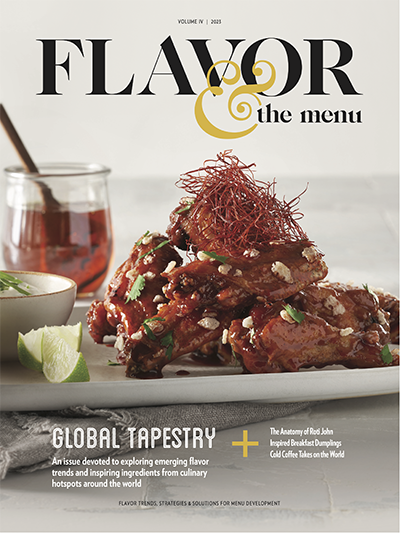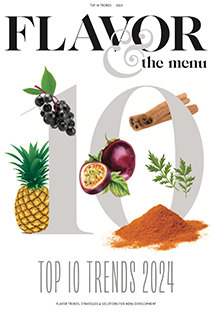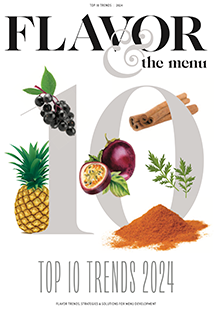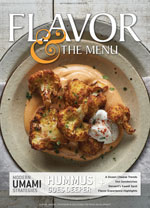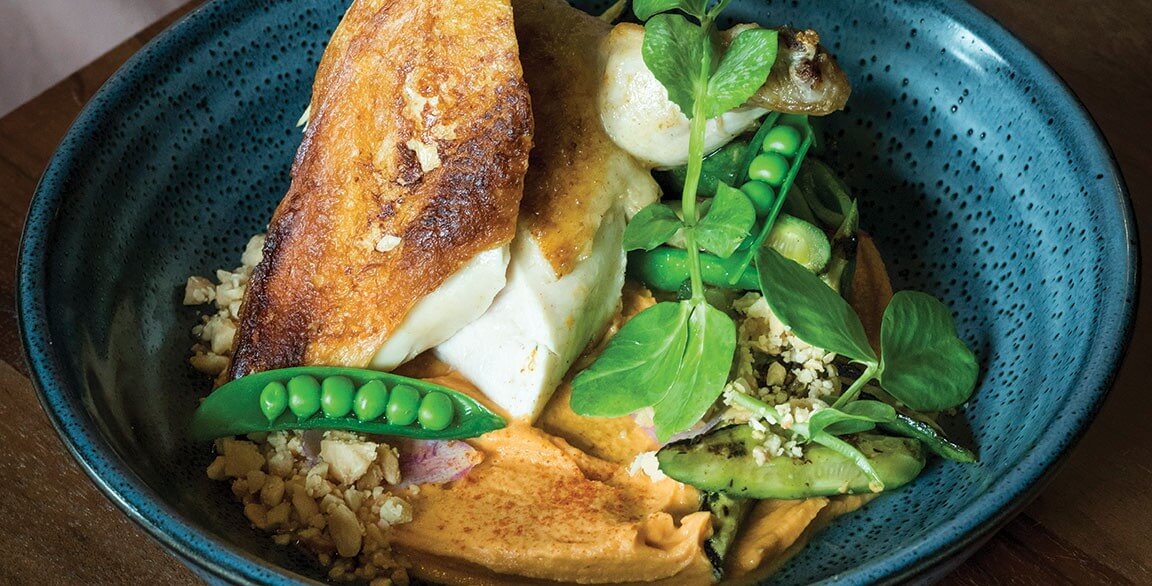
Hummus has demonstrated its staying power over the last few years. Today, chefs are capitalizing on its growing familiarity, leveraging its versatility and maximizing its noble status as a plant-based protein.
In fact, it’s that plant-based profile that has rocketed hummus through the innovation pipeline for a number of restaurant concepts.
Jason’s Deli, based in Beaumont, Texas, uses a roasted red pepper hummus as a spread on its Zucchini Grillini, a sandwich of roasted zucchini, Muenster, organic spinach, red onion, Roma tomatoes and Kalamata olives.
Salad chain Sweetgreen, based in Los Angeles, offers hummus as a salad add-in, giving consumers a plant-based protein option, as well as an unexpected textural component that elevates the experience.
And Little Sesame, a fast-casual concept based in Washington, D.C., demonstrates the endless possibilities around flavor combinations and toppers in hummus with offerings like its Edamame Hummus, crowned with Fresno pepper jelly, sheep’s milk feta, shredded carrot and local micro cilantro.
Of course, there’s also wholesomeness in hummus. “As functional foods are becoming more prevalent on menus, hummus offers health-conscious guests a reliably satisfying option,” says Travis Jenkins, R&D chef with Marlin Network, based in Springfield, Mo.
“Consumers are also more familiar with Mediterranean flavors and ingredients, recognizing that, as a cuisine, it’s one of the healthiest ways to eat.”
All of these drivers are moving hummus (along with other plant-based spreads) deeper into menu development. But let’s be clear—the opportunity here has not moved on from its glorious position as a shareable dip. Instead, hummus has simply expanded its universe, moving smoothly into menu items like bowl builds, toasts, salads, entrées and breakfast.
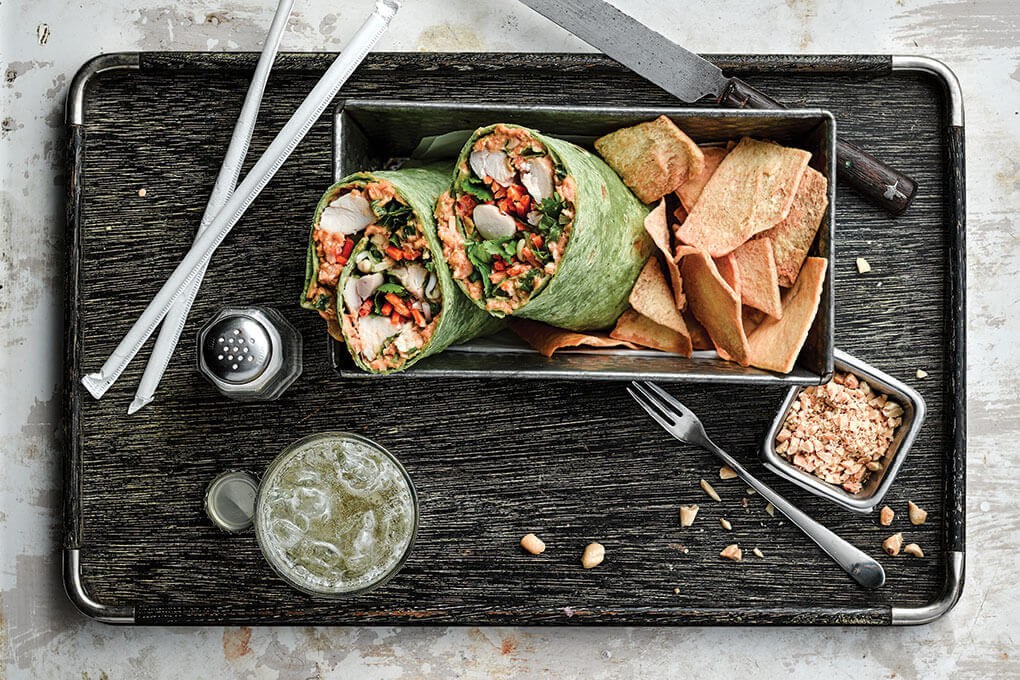 Bush’s Best
Bush’s Best In this Thai Peanut Hummus Wrap, hummus serves as the base for big flavor—ginger, Sriracha, coconut and peanut butter.
Take a Dip
With shareables continuing their reign on menus, hummus gives chefs a great launching pad for signature status.
At Jaffa, a Middle Eastern restaurant with two locations in Los Angeles, the Sweet Potato Hummus combines cashew cream, s’chug, onions and cilantro, served with pita or crudités.
Ryan Moore, executive chef of Sababa, a modern Israeli restaurant in Washington, D.C., sees hummus as a creative canvas. He brought its endless possibilities as a shareable dip into sharp focus with a promotion earlier this year called “31 Days of Hummus.” Each was served with freshly baked housemade rye pita, and flavors included Charred Carrot Hummus and Roasted Beet Hummus with pistachio and preserved orange.
A few options deftly featured modern American mash-ups, such as Hummus with Fried Green Tomatoes and Smoked Apple Hummus. “I approach hummus as a creamy, tart, savory, nutty purée that can support many flavor profiles to enhance the eating experience—either on its own, with a pita, or on your plate to marry the rest of your dish together,” says Moore.
With a flavor profile that invites signature add-ins, hummus as a dip carries menu potential that won’t run out of steam anytime soon. “Chefs can get creative and push the boundaries with signature preparations that are inspired by trending flavors and global ingredients,” says Jenkins.
To tap into the sweet-heat trend, he suggests fresh fruit and regional peppers as a topper.
“I’m a fan of combining hummus with the flavors of coconut and the fruity Peruvian pepper, aji amarillo, for a colorful, flavorful hummus that makes a great shareable, served with fresh micro coriander, lime zest and sea-salt pita chips.” Hummus is a great canvas for trending global flavors, too.
“Add gochujang paste and caramelized ginger, then top the hummus with crispy pork belly—the combination introduces subtle smokiness, sweetness and heat,” he says.
 A Summer Day Café; RyanTanaka2019; Ashlie Levy
A Summer Day Café; RyanTanaka2019; Ashlie Levy From left: Beet hummus enlivens the Mediterranean Bowl at A Summer Day Café in New York; Jaffa in Los Angeles menus a sweet potato hummus with cashew cream and s’chug; Sababa in Washington, D.C., serves roasted beet hummus with pistachio, preserved orange and feta.
Hummus Goes Deep
Chefs are using hummus elsewhere on the menu, leveraging its texture and temperature, along with its plant-centric appeal.
At Onward, a New American restaurant in Chicago, Patrick Russ, executive chef, menus a thoroughly modern entrée, pairing chicken with a swipe of romesco hummus and a finish of a bright, light salad.
“We make the vibrant romesco hummus with chickpeas, tahini, roasted peppers and almonds, then plate it cold to act as a refreshing ‘sauce’ against the hot chicken,” he says. “A bright salad of Persian cucumbers and snap peas topped with toasted Marcona almonds stands up to the hearty flavors of the dish while lending a bit of lightness.”
Restaurants that either focus on Mediterranean fare or dip into that region for inspiration have an intuitive pathway to incorporating plant-based spreads into their entrées.
At Estiatorio Milos, a Greek restaurant with locations in New York, Las Vegas and Miami, the grilled octopus is served with a Santorini fava bean purée, made with fava beans, extra-virgin olive oil, sea salt, red onion, lemon juice and pepper. Its Bigeye Tuna is accompanied by baby beets and almond skordalia, another plant-based purée that offers opportunity.
Traditionally made with either bread and garlic or potatoes and garlic, the restaurant’s version serves the former, with the addition of almonds to enhance the texture.
“Using almonds creates a perfect balance between the garlic, balsamic vinegar and olive oil,” says Jesse Maldonado, head chef at the Las Vegas location. “Skordalia is delicious with tuna or on its own with pita, but I also love to use it with anything fried, like fried soft-shell crab.”
Today’s bowl builds take a similar tack of using spreads as meal components. In fact, a mark of modern recipe building sees hummus and other plant-based spreads incorporated as an unexpected ingredient—a swipe or a dollop—adding value and interest to a build.
A Summer Day Café in New York serves a Mediterranean Bowl, which stars tabbouleh, beet hummus and feta, either topped with roast chicken or roast cauliflower. The beet hummus adds vibrant color and creamy texture, and it shows a serious commitment to functionality and wellness.
As Eastern Med concepts flourish, consumers are seeing—and enjoying—hummus on both breakfast and brunch menus. That growing familiarity presents an opportunity for restaurants looking to expand their plant-forward offerings in this space.
Sababa’s brunch menu runs its take on eggs Benedict in its Lamb & Egg, with a pita sliced in half, layered with harissa hummus and topped with schmaltz-braised lamb, poached egg and sumac onions. “The harissa hummus gives the creaminess that hollandaise would to a Benedict,” says Moore.
At Jaffa, the Hamshuka stars hummus, shakshuka sauce, poached eggs and herbs, served with pita.
Ash’Kara in Denver serves its breakfast hummus with wood-fired pita and a choice of toppings, including Bulgarian feta and organic eggs. “With the continuing rise in popularity of hummus on menus, chefs can get creative and really push the boundaries,” says Jenkins.
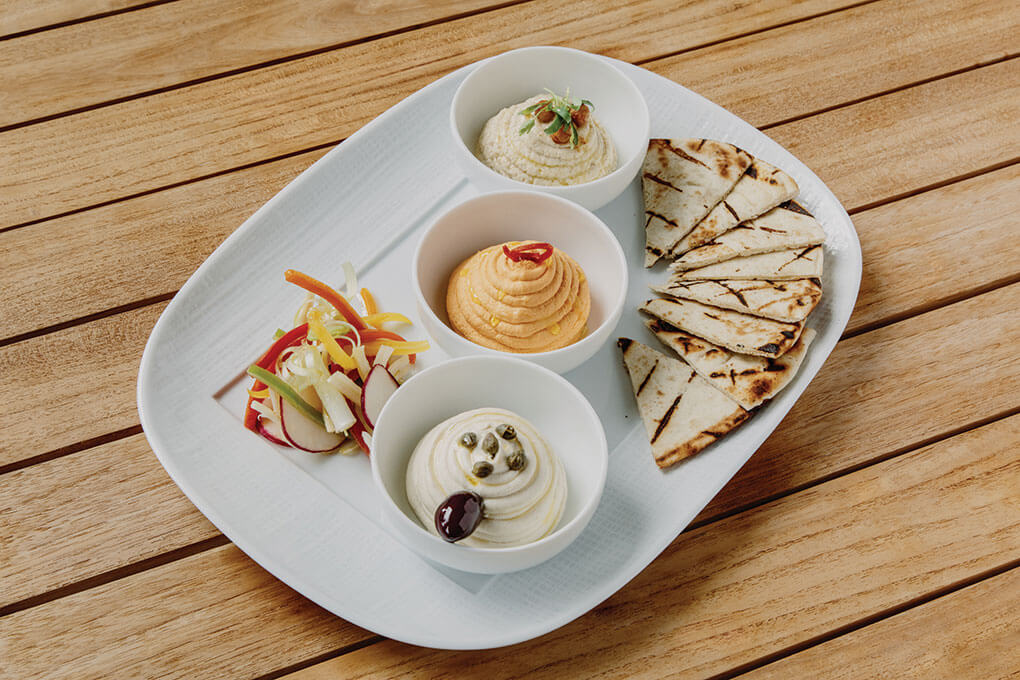 Estiatorio Milos
Estiatorio Milos Estiatorio Milos relies on plant-based spreads throughout its menu. Here, the Greek Spreads shareable stars (top to bottom) hummus, htipiti (roasted red pepper and feta) and taramasalata.

